Digs & Discoveries
A Trip to Venice
By JASON URBANUS
Tuesday, October 12, 2021
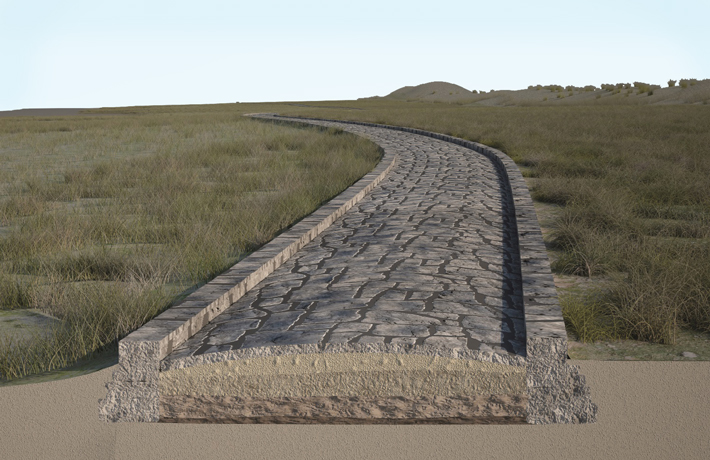 Scholars have long debated whether the Romans inhabited the Venetian lagoon, an enclosed bay on the Adriatic Sea where Venice lies, in the centuries before the city was founded in the fifth or sixth century A.D. Since much of the Roman-era landscape is now submerged under Venice’s rising waters, traces of the Romans’ presence have been difficult to detect. However, a new investigation was able to locate and map a stretch of a previously unknown Roman road now 18 feet beneath a waterway known as the Treporti Channel. The road was likely once part of a network connecting the area to the mainland and the Roman port city of Altinum. Underwater archaeologists identified Roman artifacts dating to between the first century B.C. and third century A.D., as well as the foundations of a large stone building believed to have been part of the Roman harbor infrastructure at the southern entrance to the lagoon. “This changes the perspective on the significance of the Roman settlements in the area,” says researcher Fantina Madricardo of the Italian National Research Council’s Institute of Marine Science. “They were not marginal, but permanent and diffuse.”
Scholars have long debated whether the Romans inhabited the Venetian lagoon, an enclosed bay on the Adriatic Sea where Venice lies, in the centuries before the city was founded in the fifth or sixth century A.D. Since much of the Roman-era landscape is now submerged under Venice’s rising waters, traces of the Romans’ presence have been difficult to detect. However, a new investigation was able to locate and map a stretch of a previously unknown Roman road now 18 feet beneath a waterway known as the Treporti Channel. The road was likely once part of a network connecting the area to the mainland and the Roman port city of Altinum. Underwater archaeologists identified Roman artifacts dating to between the first century B.C. and third century A.D., as well as the foundations of a large stone building believed to have been part of the Roman harbor infrastructure at the southern entrance to the lagoon. “This changes the perspective on the significance of the Roman settlements in the area,” says researcher Fantina Madricardo of the Italian National Research Council’s Institute of Marine Science. “They were not marginal, but permanent and diffuse.”
A Place of Their Own
By JOSHUA RAPP LEARN
Tuesday, October 12, 2021
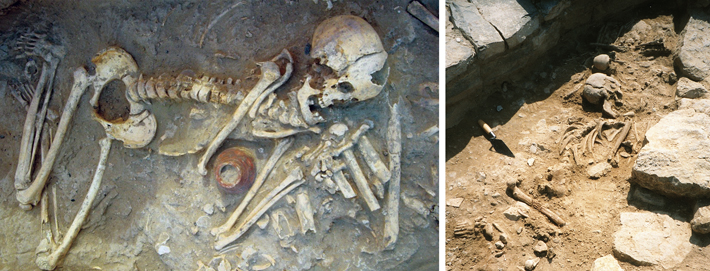 Two women buried in monumental four-millennia-old tombs located near water towers in ancient Arabia likely enjoyed special status. The tombs are associated with the Umm an-Nar culture, which lasted from about 2700 to 2000 B.C., a time when pastoralists began to shift to oasis-based agricultural systems in what is now the United Arab Emirates.
Two women buried in monumental four-millennia-old tombs located near water towers in ancient Arabia likely enjoyed special status. The tombs are associated with the Umm an-Nar culture, which lasted from about 2700 to 2000 B.C., a time when pastoralists began to shift to oasis-based agricultural systems in what is now the United Arab Emirates.
One woman was buried alongside a dog in a tomb at the site of Shimal. The canine, says bioarchaeologist Lesley Gregoricka of the University of South Alabama, appears to have been a companion or work animal, rather than a food source. While many of the other human remains in the tomb were cremated and buried together, the woman and her dog were not cremated and were buried on their own. Gregoricka speculates that the woman may have been a shepherd or hunter, and that the division of labor in this culture may have been more egalitarian than it became in later years. “The dog may have also aided her in some way—a lesion on her ankle could have impacted her mobility,” Gregoricka says.
The other woman, who was buried in a similar type of tomb at the site of Tell Abraq, was likely paralyzed from the waist down. Strong markers where the muscles attached to her shoulder, forearm, and upper arm bones reveal a great deal of strain, indicating she likely dragged herself around. Like the woman from Shimal, this woman was buried on her own. It is unclear, though, whether her special treatment in death represented a type of tribute or ostracism, says Gregoricka.
An Irish Idol
By JASON URBANUS
Tuesday, October 12, 2021
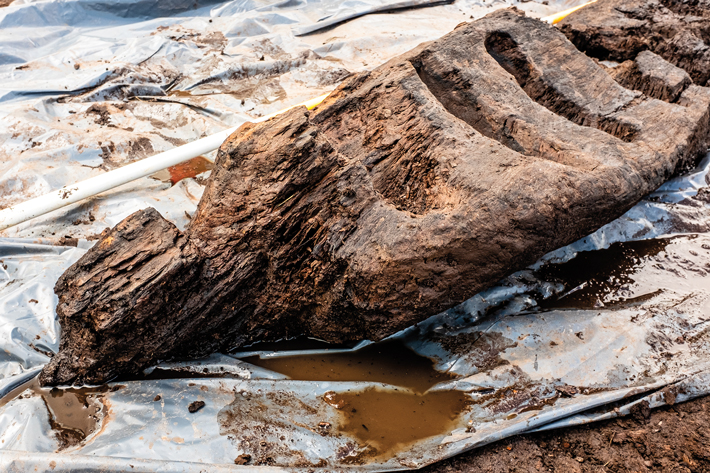 During a road construction project in County Roscommon, archaeologists recovered a 1,600-year-old wooden idol from a bog near the town of Gortnacrannagh. The eight-foot-tall figure, which may represent a pagan deity, was carved from a split oak trunk and has a small human-shaped head as well as horizontal notches cut along its length. A dozen similar ancient statues have been found across Ireland, but this is the largest to date.
During a road construction project in County Roscommon, archaeologists recovered a 1,600-year-old wooden idol from a bog near the town of Gortnacrannagh. The eight-foot-tall figure, which may represent a pagan deity, was carved from a split oak trunk and has a small human-shaped head as well as horizontal notches cut along its length. A dozen similar ancient statues have been found across Ireland, but this is the largest to date.
The idol’s discovery in a boggy landscape is significant. In ancient Irish culture, watery places were commonly associated with the supernatural otherworld, the realm of gods and heroes. Archaeologists also discovered animal bones and a ritual dagger nearby. “It was essentially a sacred wetland where, over several thousand years, people deposited special objects,” says archaeologist Eve Campbell of Archaeological Management Solutions. “It’s likely that this figure played a role in these rituals.”
A Family's Final Resting Place
By LING XIN
Tuesday, October 12, 2021
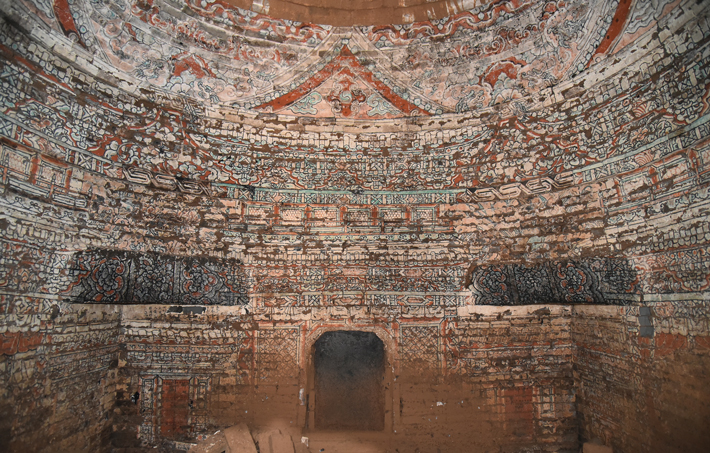
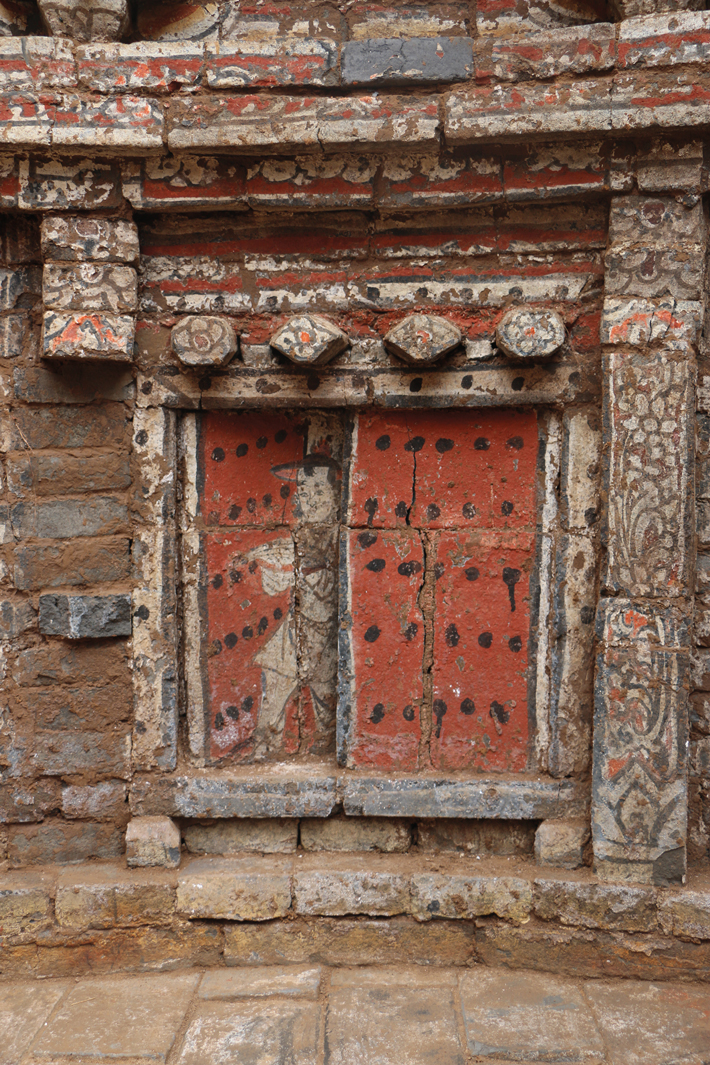 Archaeologists have unearthed a well-built and exquisitely decorated family mausoleum in Jinan, in eastern China’s Shandong Province, dating to the Yuan Dynasty (1279–1368). The 12 tombs were built to high standards, with gateways, domes, and double rooms, and contained complete sets of furniture and painted murals. The researchers also collected more than 60 artifacts, including pottery, porcelain, and bronze mirrors. Only very wealthy people could have afforded such luxury, says lead researcher Qi Xing of the Jinan Institute of Archaeology. In some of the tombs, coffins were buried under floor tiles to impede grave robbers, a very rare design feature, says Xing. The team has identified the tomb owners based on epitaphs and other written evidence as the Guo family, well-known businesspeople in the area. The bodies are believed to include those of at least five Guo brothers, their families, and their mother. The next step, Xing says, is to conduct DNA tests to find out more specifically how the tomb’s owners were related.
Archaeologists have unearthed a well-built and exquisitely decorated family mausoleum in Jinan, in eastern China’s Shandong Province, dating to the Yuan Dynasty (1279–1368). The 12 tombs were built to high standards, with gateways, domes, and double rooms, and contained complete sets of furniture and painted murals. The researchers also collected more than 60 artifacts, including pottery, porcelain, and bronze mirrors. Only very wealthy people could have afforded such luxury, says lead researcher Qi Xing of the Jinan Institute of Archaeology. In some of the tombs, coffins were buried under floor tiles to impede grave robbers, a very rare design feature, says Xing. The team has identified the tomb owners based on epitaphs and other written evidence as the Guo family, well-known businesspeople in the area. The bodies are believed to include those of at least five Guo brothers, their families, and their mother. The next step, Xing says, is to conduct DNA tests to find out more specifically how the tomb’s owners were related.
Otto's Church
By BENJAMIN LEONARD
Tuesday, October 12, 2021
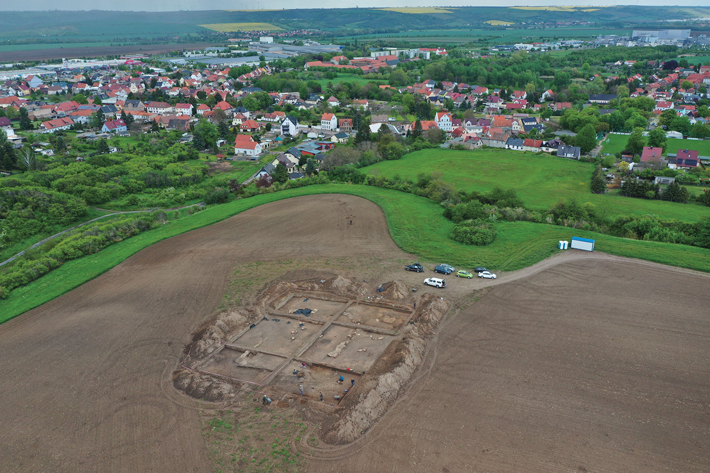 On a hill overlooking the village of Helfta, Germany, archaeologists have unearthed the remains of a cross-shaped stone basilica commissioned by Otto the Great, ruler of the Eastern Frankish Kingdom (r. A.D. 936–973) and the Holy Roman Empire (r. A.D. 962–973). Medieval chronicles record that the church was built sometime before A.D. 968 and dedicated to Saint Radegundis, a sixth-century A.D. princess who established the first women’s monastery in France. The structure, which had three aisles and measured about 100 feet long and 65 feet wide, once stood at the center of a fortified settlement that served as a royal palace for Otto and his successors. “This site was one of many palaces where kings and emperors resided,” says archaeologist Felix Biermann of the State Office for Heritage Management and Archaeology Saxony-Anhalt. “Because they had no capital cities, they would move from place to place every month or two.” It’s unclear how much time Otto spent at this particular palace, though an eleventh-century chronicle mentions that he was at least present for the church’s inaugural services.
On a hill overlooking the village of Helfta, Germany, archaeologists have unearthed the remains of a cross-shaped stone basilica commissioned by Otto the Great, ruler of the Eastern Frankish Kingdom (r. A.D. 936–973) and the Holy Roman Empire (r. A.D. 962–973). Medieval chronicles record that the church was built sometime before A.D. 968 and dedicated to Saint Radegundis, a sixth-century A.D. princess who established the first women’s monastery in France. The structure, which had three aisles and measured about 100 feet long and 65 feet wide, once stood at the center of a fortified settlement that served as a royal palace for Otto and his successors. “This site was one of many palaces where kings and emperors resided,” says archaeologist Felix Biermann of the State Office for Heritage Management and Archaeology Saxony-Anhalt. “Because they had no capital cities, they would move from place to place every month or two.” It’s unclear how much time Otto spent at this particular palace, though an eleventh-century chronicle mentions that he was at least present for the church’s inaugural services.
The settlement was abandoned in the thirteenth century, but the church continued to be used until its destruction in the fifteenth or sixteenth century. Inside and around the building, archaeologists have already excavated more than 300 burials, many of them belonging to members of noble families, including children. Several graves contained earrings, pins, and enameled brooches. Among the artifacts recovered from the church are a thirteenth-century enameled bronze crucifix and a fragment of a church bell.
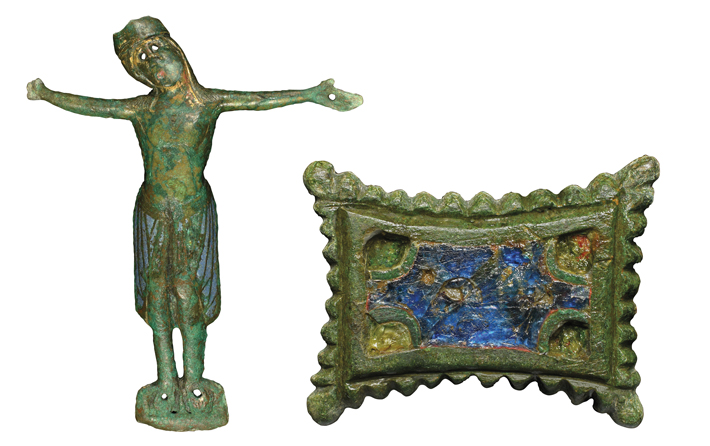
Advertisement
Advertisement
IN THIS ISSUE
Features
When Isis Was Queen
Italian Master Builders
Ghost Tracks of White Sands
Piecing Together Maya Creation Stories
Gaul's University Town
Letter from Ghana
Digs & Discoveries
Identifying the Unidentified
In Full Color
Typing Time
Otto's Church
An Irish Idol
A Family's Final Resting Place
A Place of Their Own
A Trip to Venice
Salty Snack
The Age of Glass
China's New Human Species
Mesopotamian War Memorial
Off the Grid
Around the World
Under the Temple of the Feathered Serpent, Ice Age camping in Michigan, and a Mesolithic Russian amber merchant
Artifact
Lost in translation
Advertisement

Recent Issues
-
 May/June 2024
May/June 2024
-
 March/April 2024
March/April 2024
-
 January/February 2024
January/February 2024
-
 November/December 2023
November/December 2023
-
 September/October 2023
September/October 2023
-
 July/August 2023
July/August 2023
-
 May/June 2023
May/June 2023
-
 March/April 2023
March/April 2023
-
 January/February 2023
January/February 2023
-
 November/December 2022
November/December 2022
-
 September/October 2022
September/October 2022
-
 July/August 2022
July/August 2022
-
 May/June 2022
May/June 2022
-
 March/April 2022
March/April 2022
-
 January/February 2022
January/February 2022
-
 November/December 2021
November/December 2021
-
 September/October 2021
September/October 2021
-
 July/August 2021
July/August 2021
-
 May/June 2021
May/June 2021
-
 March/April 2021
March/April 2021
-
 January/February 2021
January/February 2021
-
 November/December 2020
November/December 2020
-
 September/October 2020
September/October 2020
-
 July/August 2020
July/August 2020
-
 May/June 2020
May/June 2020
-
 March/April 2020
March/April 2020
-
 January/February 2020
January/February 2020
-
 November/December 2019
November/December 2019
-
 September/October 2019
September/October 2019
-
 July/August 2019
July/August 2019
-
 May/June 2019
May/June 2019
-
 March/April 2019
March/April 2019
-
 January/February 2019
January/February 2019
-
 November/December 2018
November/December 2018
-
 September/October 2018
September/October 2018
-
 July/August 2018
July/August 2018
-
 May/June 2018
May/June 2018
-
 March/April 2018
March/April 2018
-
 January/February 2018
January/February 2018
-
 November/December 2017
November/December 2017
-
 September/October 2017
September/October 2017
-
 July/August 2017
July/August 2017
-
 May/June 2017
May/June 2017
-
 March/April 2017
March/April 2017
-
 January/February 2017
January/February 2017
-
 November/December 2016
November/December 2016
-
 September/October 2016
September/October 2016
-
 July/August 2016
July/August 2016
-
 May/June 2016
May/June 2016
-
 March/April 2016
March/April 2016
-
 January/February 2016
January/February 2016
-
 November/December 2015
November/December 2015
-
 September/October 2015
September/October 2015
-
 July/August 2015
July/August 2015
-
 May/June 2015
May/June 2015
-
 March/April 2015
March/April 2015
-
 January/February 2015
January/February 2015
-
 November/December 2014
November/December 2014
-
 September/October 2014
September/October 2014
-
 July/August 2014
July/August 2014
-
 May/June 2014
May/June 2014
-
 March/April 2014
March/April 2014
-
 January/February 2014
January/February 2014
-
 November/December 2013
November/December 2013
-
 September/October 2013
September/October 2013
-
 July/August 2013
July/August 2013
-
 May/June 2013
May/June 2013
-
 March/April 2013
March/April 2013
-
 January/February 2013
January/February 2013
-
 November/December 2012
November/December 2012
-
 September/October 2012
September/October 2012
-
 July/August 2012
July/August 2012
-
 May/June 2012
May/June 2012
-
 March/April 2012
March/April 2012
-
 January/February 2012
January/February 2012
-
 November/December 2011
November/December 2011
-
 September/October 2011
September/October 2011
-
 July/August 2011
July/August 2011
-
 May/June 2011
May/June 2011
-
 March/April 2011
March/April 2011
-
 January/February 2011
January/February 2011
Advertisement






